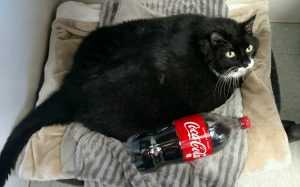While a fat cat photo might win some extra likes on social media, the consequences of obesity greatly outlast the fifteen minutes of fame. Overweight animals are at higher risk of developing life-threatening diseases, such as diabetes, arthritis, heart disease and more. In fact, your pet’s weight is one of the main factors that determines the quality and longevity of their life.
How can you tell if your pet is overweight? It can be challenging to tell if your pet is too heavy. Optimal weight and body composition are not the same for animals with a different breed, sex, or age. In general, you can often tell if your cat or dog is a healthy weight by feeling their ribs. If you have to press firmly to feel the ribs, or if you can not feel them at all, it’s a good sign that they are overweight or obese. Ultimately, if you have concerns about your pet’s weight, the best thing to do is consult a veterinarian.
What should you do if your pet is overweight? Your veterinarian can assess whether your pet’s weight is related to underlying health concerns and will make recommendations for an appropriate treatment plan. Fortunately, most cases of obesity are related to our own behavior as pet owners and can be treated by weight loss strategies that include diet modification and exercise. Your vet may recommend switching to a weight loss specific pet food. For cats, unrestricted access to food is often the main driver of obesity. Instead of free-feeding systems, stick to two meals a day according to the recommended portion sizes. For both dogs and cats, try to avoid giving excess treats, particularly table scraps which are generally higher in fat and calorie content.
In addition to diet modifications, your pet should receive appropriate amounts of exercise to aid in their weight loss. The amount and type of activity that is most appropriate will vary by breed and age. Walking, running, and swimming with your dog can be good forms of exercise, but it is important to introduce these slowly to avoid injury. Cat toys, such as laser pointers, treat dispensing balls, electronic mice, and other forms of play are great ways to burn calories – and can even be fun for you! Additionally, placing their meals in new locations around the house can encourage them to get moving, especially if they are highly food motivated.
With some extra work, your pet can reach a healthy weight that will help them live a long and healthy life by your side!

